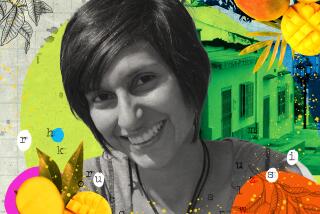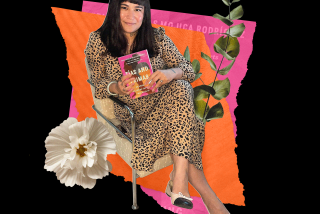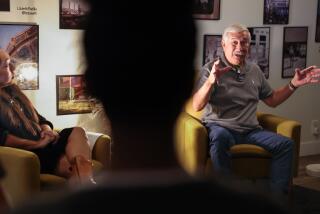Tell Us Something, Anything, Even If It’s a Lie
It has been nearly 20 years since Sandra Cisneros’ acclaimed first novel, “The House on Mango Street,” a coming-of-age story told in poetic vignettes, brought her unique voice and the Chicana experience to millions of American readers. High school and college students in particular found her first novel authentic and simpatico. Her 1991 short story collection, “Woman Hollering Creek,” offered a wider range of voices, a broader scope.
With “Caramelo,” her exuberant, overstuffed new novel, she undertakes storytelling on a grand scale, detailing the struggles and joys of three generations of a family that bridges the Mexican, Mexican American and American experiences during the momentous migrations of the last century, evoking a subtle panorama of cultural shifts. Its characters leap from the page in all their flawed humanity, falling in and out of love, squabbling and making up, working hard and making do.
Cisneros, the daughter of a Mexican father and a Chicana mother, considers herself a “bicultural citizen.” In “Caramelo,” she blends English and Spanish language and literary traditions (among them the picaresque novel and the testimonio, the Latin American testimonial narrative that often incorporates oral history) into her own unprecedented mix. She weaves Spanish words, phrases, song lyrics and poems throughout the novel. “Spanish gives me a way of looking at myself and at the world in a new way,” she has said. “For those of us who are living between worlds, our job in the universe is to help others see with more than their eyes during this period of chaotic transition.” (“Caramelo” is being published simultaneously in Spanish.)
“Caramelo” opens with a postmodern caveat: “The truth, these stories are nothing but story, bits of string, odds and ends found here and there, embroidered together to make something new. I have invented what I do not know and exaggerated what I do to continue the family tradition of telling healthy lies. “
The chief storyteller is Celaya (or Lala) Reyes, her family’s only daughter. “I am the favorite child of a favorite child. I know my worth. Mother named me after a famous battle where Pancho Villa met his Waterloo. I am the seventh born in the Reyes family of six sons.”
Lala’s beloved father, Inocencio, and his two brothers, Uncle Fat-Face and Uncle Baby, have settled in Chicago to run a furniture upholstering business. The first section of the novel tells of the fateful car trip their families take across the border to spend the summer in Mexico City with the “Little Grandfather,” “Awful Grandmother,” “Aunty Light-Skin” and her daughter. The trip involves three couples, three cars, 12 children. This is at mid-century, in the days before air conditioning.
“--Are we in Mexico yet?--No, not yet. [Sleep, wake up.]--Are we in Mexico yet?--Still Texas. [Sleep, wake up.]--Are we ... --Christ Almighty!!!”
Then comes the border. “No more billboards announcing the next Stuckey’s candy store, no more truck-stop donuts or roadside picnics with bologna-and-cheese sandwiches and cold bottles of 7-Up.... Now we’ll drink fruit-flavored sodas, tamarind, apple, pineapple.... The smell of diesel exhaust, the smell of somebody roasting coffee, the smell of hot corn tortillas along with the pat-pat of the women’s hands, making them, the sting of roasting chiles in your throat and in your eyes.”
In the course of the summer, the brothers and their families quarrel, Uncle Fat-Face and Uncle Baby take off, and Inocencio’s family stays, increasing the tension between his wife and his possessive mother. This conflict reaches a crescendo when the remaining family group spends a few days in Acapulco.
Candelaria, the daughter of the Awful Grandmother’s washerwoman, comes along to help out. Lala, who noticed her first for her skin color--caramelo, the golden color of burnt-milk candy--already has found her an appealing playmate. Candelaria is the centerpiece of a major blowup when the Awful Grandmother tells her daughter-in-law, Lala’s mother, a terrible secret. (We don’t learn what it is until nearly the end of the book.) At this point, in a long middle section, Lala chronicles the early life of her grandparents, before the Awful Grandmother became awful. Lala’s narrative is sometimes interrupted by boldface questions from her disembodied grandmother, who argues that she should be portrayed in a positive light:
“--You have the sensitivity of an ax murderer. You are killing me with this story you’re telling.”
“--Nobody wants to hear your invented happiness,” responds Lala, who understands the basis for a satisfying story, be it Tolstoy or Telemundo. “It’s your troubles that make a good story. Who wants to hear about a nice person? The more terrible you are, the better the story. You’ll see .... “
The Awful Grandmother once was a girl named Soledad, the daughter of master makers of rebozos, the traditional Mexican shawls. Her father specialized in black shawls, black being the most difficult color to dye; her mother was expert at knotting fringe into elaborate designs, some of which took 146 hours to complete. Soledad’s mother dies while she is still a baby, leaving behind an unfinished rebozo. “Even with half its fringe hanging unbraided like mermaid’s hair, it was an exquisite rebozo... the cloth a beautiful blend of toffee, licorice and vanilla stripes flecked with black and white, which is why they call this design a caramelo.” Soledad’s father remarries and sends her to a cousin, who puts her to work as a servant. The unfinished candy-striped caramelo rebozo comforts her and weaves its way through the rest of the story, ultimately becoming Lala’s prized possession.
In the third and last section of the novel, Lala begins to grow up. Her grandmother sells her house in Mexico and comes to live with her family; they travel from Chicago to San Antonio and back again, descending deeper into poverty. For reasons that don’t seem clear, she has a fling with Ernesto, a buddy of her brothers. Her best friend in San Antonio, a feisty seventh-generation Tex-Mexican, comes and goes too quickly. In fact, a number of secondary characters--including those six brothers, the uncles, aunts and cousins--pale in comparison to those closest to Lala, especially her father and grandmother.
Cisneros incorporates footnotes into the narrative, comprising Lala’s digressions from the main story line; snatches of Mexican history (cross-border skirmishes such as Woodrow Wilson’s invasion of Tampico in 1914 and Pancho Villa’s 1916 raid on Columbus, N.M., for instance); and commentary on pop culture figures, such as Senor Wences, the Mexican ventriloquist who was a regular on “The Ed Sullivan Show” and one of the first Latinos to appear on U.S. television, and Pedro Armendariz, the Mexican film idol whom Elia Kazan wanted for the starring role in “Viva Zapata” that went to Marlon Brando. Some of these footnotes are enlightening; others seem unfinished. But for the most part, Cisneros, like a masterful rebocero, artfully weaves together the various threads of her story: “The universe a cloth, and all humanity interwoven,” says Lala. “Each and every person connected to me, and me connected to them, like the strands of a rebozo. Pull one string and the whole thing comes undone.”
“Caramelo” is infused with the permanent nostalgia of exile, of those who live in between cultures. Inocencio Reyes, Lala’s father, experiences “that terrible ache and nostalgia for home when home is gone.... In less than three hours we could be at the border, but where is the border to the past, I ask you, where?”
Like Eduardo Galeano, John Dos Passos and John Steinbeck, Cisneros writes along the borders where the novel and social history intersect. She is particularly gifted at showing how the ebb and flow of history affect those previously marginalized: the poor, the immigrants, the women who have been traditionally without a voice in literature. In this lovingly told and poetic novel, she uses the storytelling art to give these voiceless ones a voice, and to find the border to the past, imbuing the struggles of her family and her countries with the richness of myth.
More to Read
Sign up for our Book Club newsletter
Get the latest news, events and more from the Los Angeles Times Book Club, and help us get L.A. reading and talking.
You may occasionally receive promotional content from the Los Angeles Times.






